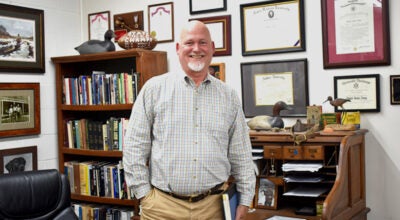Bradshaw-Chambers Library to host travel exhibit
Published 11:00 am Wednesday, June 22, 2022
|
Getting your Trinity Audio player ready...
|
VALLEY — Bradshaw-Chambers County Library has an exhibit that’s appropriate for the summer season, the time of year when people take the trip of a lifetime. Compiled by archivist Robin Watson, the exhibit is entitled “Going Places: Tales of Travel and Adventure Both Near and Far!”
It fills the library’s main display cases and will be on view for the remainder of the summer.
One exhibit recounts the mountain climbing experiences of Valley native Hugh Morton, who made trips to the earth’s seven continents to achieve his goal of completing the Seven Summits Challenge. He started with Kilimanjaro in Africa in 1988 and finished with Vinson Massif in Antarctica in 1999. The climbing was the hard part but getting there and returning was an adventure.
One of the cases tells of the trip people from Ireland made to the Valley in 2001. The Parnell Society made a trip to America to see places where Charles Stewart Parnell visited in America. He’s been called the uncrowned king of Ireland, and one of the places he visited in the 1870s was the peach farm of his older brother, John Parnell, which was located off River Road.
The current exhibit tells the story of Sally and Willy Creigh, two sisters from Mobile who traveled to see exotic places early in the 20th century. There’s a photo of them riding camels with Egyptian pyramids behind them. The Creigh sisters were related to Virginia Glover Cook, wife of Batson-Cook founder Edmund Cook.
“They went to Egypt in 1907,” Watson said. “This was well before King Tut’s tomb was discovered. They were interesting people and had lived in Europe for a time.”
Watson said she loved the photo of the two women on camels wearing the Edwardian fashions of the day.
Watson knows what it’s like to be on a camel’s back. She rode one in Jordan several years ago on a trip to the Middle East with Louise Cox.
The display recounts the story of two local missionaries who traveled far and wide. Their names were Virginia Atkinson and Margaret Cook, youngest sister of Ellison “Dad” Cook, who wrote a popular column for The Chattahoochee Valley Times. By the 1930s, Cook and two other women from West Point, Mary Poer Oslin and Mrs. A.D. Ferguson, had tour businesses.
These tour directors would handle all the details for tours to places like Washington, D.C., New York City, Niagara Falls, Canada, and far west destinations such as the Pacific coast where visitors could see the giant Redwood trees, the Grand Canyon, Yellowstone and the Sequoia National Park.
There’s information on the first documented trip to the Valley by an American of European heritage. Benjamin Hawkins, an Indian agent for President George Washington, kept a journal of his trip along the west bank of the Chattahoochee in the fall of 1798. He crossed over streams the native Creeks creeks knew by such names as Hal-0-wak-ee, O-soo-nip-ah and O-soon-a-wa-hatchee (now known as Moore’s Creek). Hawkins described an impressive view of the river in what’s now Langdale. One gets the same view today from the third floor of EAMC-Lanier Hospital.
One of the more interesting stories in the display is that of Arthur Mitchell. He was to politics what Joe Louis was to sports. Both Louis and Mitchell were born in the LaFayette area and moved north as part of the Great Migration in the early portion of the 20th century. Joe Louis went with his family to Detroit and became famous as one of the all-time greats as a boxer. Mitchell (1883-1968) grew up in Alabama and graduated from Tuskegee Institute before heading north. In 1934, he became the first African-American to be elected to the U.S. Congress as a Democrat. He served four terms and illustrated the shift among black voters to the Democratic Party. African-Americans who had previously been elected to Congress were Republicans. Mitchell was the only member of Congress who was African-American from 1935 to 1943. He was a strong supporter of President Franklin Roosevelt’s New Deal and gave a seconding speech in support of FDR at the 1936 Democratize Convention.
Mitchell is in the current travel exhibit due to a trip he took by rail in 1937. He was traveling from Chicago to Hot Springs, Arkansas on the Rock Island and Pacific Railroad. He began the trip in a VIP Pullman car near the front of the train. He had boarded the train with two first-class tickets for the entire journey, but when the train crossed the Mason-Dixon line he was ordered onto a passenger car near the back of the train that had been reserved for African Americans. Mitchell sued the railroad over this, and after being denied in lower courts fought it all the way to the U.S. Supreme Court, where in 1941 he won in the now-famed Mitchell v. United States court case. The high court ruled that Black passengers had a right to the same accommodations and treatment White passengers were given. Mitchell hailed the decision as “a step in the destruction of Jim Crow himself.” Even so, the Interstate Commerce Commission did not prohibit segregation on interstate buses or trains and in the public waiting rooms of railroads or bus stations until 1955.
The exhibit has information on a trip West Point Manufacturing Company President George H. Lanier made to Rotary International’s Convention in 1921. It took place in Scotland.
Around the same time, Shaefer Heard of the West Point Lions Club represented local Lions at the national convention in Oakland, California.
Many local people will remember a trip taken by two local men in the 1970s. Freddy Hamby and Charles “Seagull” Dailey qualified for a new record in the Guinness Book of World Records. The category they entered was the world’s longest taxi ride. They began the journey in West Point, Georgia with a goal of going through towns named West Point in a number of different states. They had to cut their planned trip short when one of the two men became ill, but they traveled far enough to qualify for the record. It’s been broken many times since, but Hamby and Dailey had it for a time.
Anyone who was taught by Joe Hall at Valley High in the 1960s and 1970s knows what an exceptional teacher he was. He was ambidextrous. When he was writing something on the left side of the chalkboard, he would do it with his left hand, and when he was on the right side he write with his right hand. Mr. Joe always talked to his students about wanting to do some traveling when he retired. They took care of it for him, arranging trips by Greyhound bus out west and even a plane flight to Hawaii. Momentoes from those trips are in one of the display cases.
Such trips were well deserved. Hall had served as a chaperone on many trips taken by VHS seniors to Washington and New York.
The exhibit tells an interesting story about a woman from Standing Rock named Virginia Hines. In the 1930s, she was part of something known as the Georgia Caravan, which took bus trips with students to the western U.S. They would travel by day and camp out during the night.
“She went on all kinds of neat trips when she was older,” Watson said.
There’s a bit of humor in an exchange between early 20th century editors of The LaFayette Sun and The Roanoke Leader.
Mr. Stevenson of the Roanoke paper poked some fun at Sun editor Sam Oliver, who had just gotten a new car in 1907. “While spinning the thing around the courthouse square, the pesky thing threw a wrench at him, mashing his mouth,” Stevenson wrote. “Better trade it in for a mule.”
This drew a response from Oliver in the next edition of The Sun.
“Thanks for the advice, Brother Stevenson, but I’d rather run the risk of being struck by an automobile than being kicked by a mule.”
Watson said she really enjoyed getting the exhibit together.
“From start to finish, it took a couple of months,” she said. “We wanted to do something for the summer season, and we first needed to settle on a theme. We went back to collections to see what we had on the subject of traveling. We had no trouble in filling up nine display cases.”
The vertical case has the uniform Carol Wood of West Point wore when she was a ticket agent for Eastern Airlines in Atlanta.





